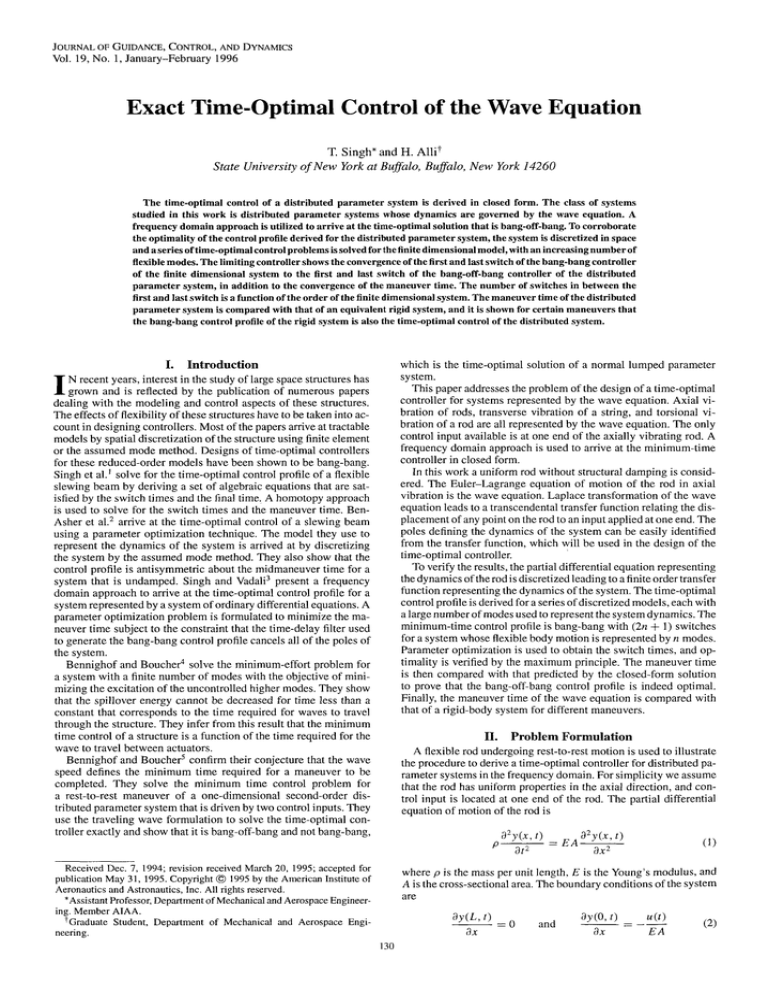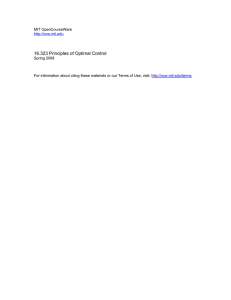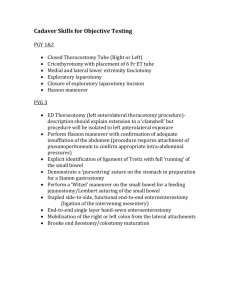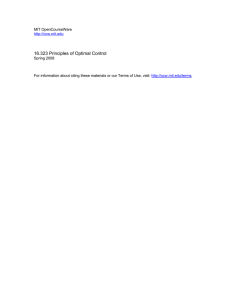
JOURNAL OF GUIDANCE, CONTROL, AND DYNAMICS
Vol. 19, No. 1, January-February 1996
Exact Time-Optimal Control of the Wave Equation
T. Singh* and H. Alii1"
State University of New York at Buffalo, Buffalo, New York 14260
The time-optimal control of a distributed parameter system is derived in closed form. The class of systems
studied in this work is distributed parameter systems whose dynamics are governed by the wave equation. A
frequency domain approach is utilized to arrive at the time-optimal solution that is bang-off-bang. To corroborate
the optimally of the control profile derived for the distributed parameter system, the system is discretized in space
and a series of time-optimal control problems is solved for the finite dimensional model, with an increasing number of
flexible modes. The limiting controller shows the convergence of the first and last switch of the bang-bang controller
of the finite dimensional system to the first and last switch of the bang-off-bang controller of the distributed
parameter system, in addition to the convergence of the maneuver time. The number of switches in between the
first and last switch is a function of the order of the finite dimensional system. The maneuver time of the distributed
parameter system is compared with that of an equivalent rigid system, and it is shown for certain maneuvers that
the bang-bang control profile of the rigid system is also the time-optimal control of the distributed system.
which is the time-optimal solution of a normal lumped parameter
system.
This paper addresses the problem of the design of a time-optimal
controller for systems represented by the wave equation. Axial vibration of rods, transverse vibration of a string, and torsional vibration of a rod are all represented by the wave equation. The only
control input available is at one end of the axially vibrating rod. A
frequency domain approach is used to arrive at the minimum-time
controller in closed form.
In this work a uniform rod without structural damping is considered. The Euler-Lagrange equation of motion of the rod in axial
vibration is the wave equation. Laplace transformation of the wave
equation leads to a transcendental transfer function relating the displacement of any point on the rod to an input applied at one end. The
poles defining the dynamics of the system can be easily identified
from the transfer function, which will be used in the design of the
time-optimal controller.
To verify the results, the partial differential equation representing
the dynamics of the rod is discretized leading to a finite order transfer
function representing the dynamics of the system. The time-optimal
control profile is derived for a series of discretized models, each with
a large number of modes used to represent the system dynamics. The
minimum-time control profile is bang-bang with (2n + 1) switches
for a system whose flexible body motion is represented by n modes.
Parameter optimization is used to obtain the switch times, and optimality is verified by the maximum principle. The maneuver time
is then compared with that predicted by the closed-form solution
to prove that the bang-off-bang control profile is indeed optimal.
Finally, the maneuver time of the wave equation is compared with
that of a rigid-body system for different maneuvers.
I. Introduction
N recent years, interest in the study of large space structures has
grown and is reflected by the publication of numerous papers
dealing with the modeling and control aspects of these structures.
The effects of flexibility of these structures have to be taken into account in designing controllers. Most of the papers arrive at tractable
models by spatial discretization of the structure using finite element
or the assumed mode method. Designs of time-optimal controllers
for these reduced-order models have been shown to be bang-bang.
Singh et al.1 solve for the time-optimal control profile of a flexible
slewing beam by deriving a set of algebraic equations that are satisfied by the switch times and the final time. A homotopy approach
is used to solve for the switch times and the maneuver time. BenAsher et al.2 arrive at the time-optimal control of a slewing beam
using a parameter optimization technique. The model they use to
represent the dynamics of the system is arrived at by discretizing
the system by the assumed mode method. They also show that the
control profile is antisymmetric about the midmaneuver time for a
system that is undamped. Singh and Vadali3 present a frequency
domain approach to arrive at the time-optimal control profile for a
system represented by a system of ordinary differential equations. A
parameter optimization problem is formulated to minimize the maneuver time subject to the constraint that the time-delay filter used
to generate the bang-bang control profile cancels all of the poles of
the system.
Bennighof and Boucher4 solve the minimum-effort problem for
a system with a finite number of modes with the objective of minimizing the excitation of the uncontrolled higher modes. They show
that the spillover energy cannot be decreased for time less than a
constant that corresponds to the time required for waves to travel
through the structure. They infer from this result that the minimum
time control of a structure is a function of the time required for the
wave to travel between actuators.
Bennighof and Boucher5 confirm their conjecture that the wave
speed defines the minimum time required for a maneuver to be
completed. They solve the minimum time control problem for
a rest-to-rest maneuver of a one-dimensional second-order distributed parameter system that is driven by two control inputs. They
use the traveling wave formulation to solve the time-optimal controller exactly and show that it is bang-off-bang and not bang-bang,
I
II. Problem Formulation
A flexible rod undergoing rest-to-rest motion is used to illustrate
the procedure to derive a time-optimal controller for distributed parameter systems in the frequency domain. For simplicity we assume
that the rod has uniform properties in the axial direction, and control input is located at one end of the rod. The partial differential
equation of motion of the rod is
(i)
a*2
Received Dec. 7, 1994; revision received March 20, 1995; accepted for
publication May 31, 1995. Copyright © 1995 by the American Institute of
Aeronautics and Astronautics, Inc. All rights reserved.
* Assistant Professor, Department of Mechanical and Aerospace Engineering. Member AIAA.
t Graduate Student, Department of Mechanical and Aerospace Engineering.
where p is the mass per unit length, E is the Young's modulus, and
A is the cross-sectional area. The boundary conditions of the system
are
and
130
,0
3x
EA
131
SINGH AND ALLI
The structure of the time-delay filter is selected to generate a
control profile that is antisymmetric about the midmaneuver time.
This follows from a result presented in a paper by Singh and Vadali,3
where the authors illustrate that the time-optimal control profile for
an undamped system is antisymmetric about the midmaneuver time,
which reduces the number of parameters to be solved for. They
further show that the antisymmetric profile cancels the rigid-body
poles of the system, thus satisfying the velocity boundary conditions
for a rest-to-rest maneuver. The transfer function of the time-delay
filter is
where L is the length of the beam and the initial and final conditions
are
By(*,t)
dt
y(x,tf) = ;
=0
(3)
x e [0, L]
which imply a rest-to-rest maneuver. Laplace transformation of
Eq. (1) leads to
y"(x,s)-c2s2y(x,s) =
(4)
Q —\ _
where (•)' indicates the partial derivative of (•) with respect to the
spatial coordinate and
c2 = p/EA
where T2 is the midmaneuver time and T2 — T\ is the first switch
time. The zeros of the time-delay filter have to cancel all of the poles
of the transfer function of the distributed parameter system [Eq. (9)],
which can be rewritten using product expansion as6
(5)
where 1/c is the wave speed. The transformed boundary conditions
are
y (L, j) = 0
and
y(0, s) = -[u(s)/EA]
y(x,s) ^
u(s)
[4c2s2(L-x)2]/[(2k-l)2n2]}
1
~ EAcs
(6)
(12)
where the control input is constrained to lie in the range
Equation (12) indicates that the transfer function poles defined by
- U < M (0 < U
(7)
sk = ±(kn/cL)j
The solution of the differential equation (4) is
y(xt s) = c\ cosh (csx) + c2 sinh (csx)
(8)
y(x,s) _ cosh[c5(L — x)]
u(s) ~ csEAsinh(csL)
k = 1 , 2 , . . . , oo
s = ja>
(14)
since we know that we are required to cancel poles that are located on the imaginary axis. Tlie zeros are determined from the
equations
(9)
1 - cos[a>(r2 - TI)] - cos[co(T2 + TI)] + cos(2a>T2) = 0 (15)
The transcendental transfer function indicates that the system response is defined by an infinite number of modes. The time response
of the system can be derived by the inverse Laplace transform of
and
Eq. (9), which is
-sin[o)(r2 - TI)] - sinMTi + TI)] + sin(2^72) = 0
y(x,t)= I
Jo EAc
2cL
••^r.,
(13)
are located on the imaginary axis.
The zeros of the time-delay filter can be determined by equating
the real and imaginary parts of Eq. (U) to zero, after substituting
The constants c\ and c2 are obtained by evaluating the boundary
conditions [Eq. (6)] at x = 0 and L. The transfer function of the
system can now be represented as
(-1)"
(16)
which can be simplified to
{^f
III.
(U)
2cos(o;r2)[-cos(a>ri) + cos(ft;r2)] = 0
(17)
2sin(o>r2)[-cos(a;r1) + cos(a;r2)] = 0
(18)
and
Time-Optimal Control Design
respectively. Equations (15) and (16) can be derived in the time
domain as well using the superposition principle.2 Thus, we
require
Singh and Vadali3 have shown that the time-optimal control profile for a finite dimensional system can be reformulated as the design of a time-delay filter, a set of zeros of which cancel all of the
poles of the system. The time-delay filter is constrained to produce
a bang-bang output when it is subject to a step input. We adopt
the same approach to derive the time-optimal control profile for the
distributed parameter system. Following Bennighof and Boucher,5
who state that the time-optimal control profile for distributed parameter systems is bang-off-bang rather than bang-bang, we state
our optimization problem as the design of a time-delay filter that
generates a bang-off-bang profile when it is subject to a step input as shown in Fig. 1. This bang-off-bang profile represents the
parametrized open-loop time-optimal control.
cos(o)T2) = cos(cori)
(19)
to satisfy Eqs. (17) and (18). The solution of Eq. (19) is
T2 = ±7i + (2knn/a>)
k, n = 1, 2, 3 , . . . , oo
We include two integer variables k and n into Eq. (20), since we
intend to cancel the infinite modes
(21)
) = kn/cL
1
i7 —e*~ ( 2~
* i)M
S
T
T
s
—e»~
T
+T
*
( 2
(20)
* +e
24
l) j. ~~
2s T
—>
*
1
time
TI
4————
T
2
2T\
Fig. 1 Time-delay filter.
*
132
SINGH AND ALLI
where k ranges from 1 to oo. The index n is used to indicate the
multiplicity of solutions of Eq. (19) that cancels all poles given by
Eq. (21). Substituting Eq. (21) into Eq. (20), we have
T2 = ±7} + 2nd
(22)
T2 = -Ti+2ncL
(23)
Assuming
the bang-off-bang control profile can be represented as
-2sncL
- e-
u(s) =
^CL
(24)
We need to determine T\ such that the boundary conditions of the
rest-to-rest maneuver are met. Substituting Eq. (24) into Eq. (12)
and applying the final value theorem, we have
0.8
0.6
0.4
= lim y(x, t) = lim sy(x, s)
t -» oo
.v -» 0
Time (sec)
- l) 2 7r 2 ]}
[4cV(L -
= lim = ———-y-+o
EAcs
-h
- ~2s(ncL-T^
L
'2sncL + e-
= 0
Fig. 2
o" "
o
0.2
x (space)
Time-optimal response forjy = 1.
(25)
Applying L'Hospital rule twice, we can show that
T{=c[nL-(yfEA/4Un)]
(26)
T2 = c[nL + (yfEA/4Un)]
(27)
and
where yf represents the final displacement.
Since T\ is a positive number, this solution is valid only when
4LUn2
EA
(28)
When Eq. (28) is violated, the second possible solution from Eq. (22)
leads to
T2 = T! + 2nd
(29)
0.6
0.4
0.2
Time (sec)
-0 -0
x (space)
Fig. 3 Time-optimal response forj/ = 5.
and the resulting control profile is
U(S)
= (U/S)[\
- e~2sncL - e-^ncL + T,)
+ e -2,(2ncL
+ r,)J
(3Q)
We can now solve for T\ and T2 using the procedure delineated
earlier that results in
(yfEA/4Un)]
(31)
and
(yfEA/4Un)]
(32)
Since the maneuver time is Tf = 2T2, we see that, irrespective
of whether T2 = -T{ + 2ncL or r2 = 7\ + 2nd, the maneuver
time is
Tf = c[2nL + (yfEA/2Un)]
(33)
To illustrate the two solutions predicted by the frequency domain
approach, we assume that p, EA, L, and U are equal to 1. Results
of the simulation of Eq. (10) for the case when yf = 1 is shown in
Fig. 2, which exemplifies the mechanism of motion of the flexible
rod. A traveling wave is generated by the first pulse that travels along
the length of the rod and is reflected at the uncontrolled end and is
finally canceled by the second pulse of the time-optimal control
profile. The parameters of the time-optimal control are defined by
Eqs. (26) and (27).
For the case when yf = 5, the parameters of the time-optimal
control are defined by Eqs. (31) and (32). Results of the simulation
of Eq. (10) indicate that the wave generated by the first pulse is
reflected twice before it is canceled by the second pulse (Fig. 3).
IV.
Verification of Optimality
To corroborate the optimality of the closed-form time-optimal
solution, we solve a series of discretized problems that in the limit
should indicate the convergence of the first and last switch time and
maneuver time to the exact solution. The assumed mode method is
used to discretize the floating flexible rod whose governing vector
differential equation of motion is
MX + Kx = bu
b, x
(34)
where n is the number of flexible modes used to represent the system
dynamics. The term M is the mass, K is the stiffness matrix, and
b is the control influence vector. To illustrate the optimality of the
exact time-optimal controller, we assume that p, EA, L, and U are
equal to 1.
A parameter optimization problem is formulated for the
discretized system as proposed by Singh and Vadali.3 Since the
discretized model of the flexible rod is normal,7 the necessary conditions for optimality are also the sufficient conditions. It can be
shown that the time-optimal control profile for an undamped system is antisymmetric about the midmaneuver time,3 which leads to
the reduction of the number of parameters to be optimized for. A
series of optimal control problems for a rest-to-rest maneuver of
yf = 1 are solved with an increasing number of flexible modes,
and the resulting control profiles are examined. Figure 4 illustrates
the time-optimal control profiles for discretized systems where the
number of flexible modes (Nfm) ranges from 1 to 8.
It is evident from Fig. 4 that the first switch time is converging to
0.5 s, the final switch time to 2.0 s, and the maneuver time to 2.5 s.
SINGH AND ALLI
133
Table 1 Switch times and maneuver time of discretized systems
0.7309
0.6367
0.5902
0.5634
0.5466
0.5355
0.5278
0.5223
o AC\r\f>
1.2003
0.9254
0.7897
0.7097
0.6583
0.6234
0.5987
0.5805
1.2352
1.0139
0.882
0.7957
0.7357
0.6921
0.6595
tl
l-o
1°
1
2
3
2.4704
O A QC\fi
——
1.248
1.0954
0.987
0.9067
0.8451
o AQfcO
1.2492
1.1178
1.0198
0.9442
1.2497
1.1345
1.0453
——
——
2.4984
1.2499
1.1474
——
1.2499
2.4998
2.4998
O AQQA
)
1
2
3
Time (sec)
jwcr:
2
3
I~
1
2
Time (sec)
0
Time (sec)
1
1.2448
1.0638
0.9436
0.8588
0.7966
0.7494
——
——
JUO2
Time (sec)
1
——
2
1
Time (sec)
3
2
Time (sec)
f 1
£ 0
Q-1
1
1
2
Time (sec)
2
Time (sec)
10
15
20
25
30
35
40
45
Fig. 4 Time-optimal control profiles for discretized system.
Fig. 5 Maneuver times for flexible and rigid systems.
In the interval from 0.5 to 2.0 s, an increasing number of switches
exist with an increase in the number of modes used to represent the
flexible body motion of the rod. In the limit, one can conjecture that
there exists chattering at infinite frequency, since the Pontryagin
maximum principle requires the time-optimal control profile of a
normal system to be bang-bang. Thus, the average of the control in
the interval between the first and last switch time is zero. Table 1
lists the optimal parameters of the time-delay filter that generates the
time-optimal control for systems with one to eight flexible modes
used to represent the system dynamics. It is evident from Table 1
that the first switch time is tending toward 0.5 and the maneuver time
toward 2.5. Table 1 lists the switch times before the midmaneuver
time and the final time.
For a final displacement yf equal to 1, the exact time-optimal
control profile is characterized by the switch times and the maneuver
time that are
= 2.0
= 0.5
and
Tf = 2.5
(35)
This confirms that the bang-off-bang control profile is the timeoptimal control of the wave equation.
V.
Comparison with a Rigid Model
(36)
which can be rewritten as
Tmin _
(39)
which can be rewritten as
(40)
where m = pL. Figure 5 illustrates the variation of the nondimensionalized maneuver time of the wave equation and the equivalent
rigid system as a function of the nondimensionalized displacement.
It can be seen that the curve representing the solution of the wave
equation is tangential to the solution of the rigid case at discrete
points, which indicates that for certain maneuvers the rigid-body
solution is also the solution of the wave equation.
The parameters for which the solution of the wave equation is the
same as that of the rigid case correspond to the situation when the
first switch time is equal to the midmaneuver time. Therefore
= c[nL - (yfEA/4Un)]
yfEA/UL=4n2
cL ~ 2UncL
2n
(37)
where the left-hand side of Eq. (37) is the nondimensionalized time
and n must satisfy the inequality
4n(n - 1) < (yfEA/UL)
< 4n(n
(41)
(38)
(42)
Figure 5 indicates that the curve representing the nondimensionalized maneuver time is piecewise linear. The location of change of
slope of the final time as a function of the maneuver can be determined by equating the solution of the maneuver time for successive
values of n:
7min —
y/EA
=0
which leads to
To compare the time-optimal controller of the wave equation with
the time-optimal controller for a rigid system with the same mass,
for a variety of maneuvers, we nondimensionalize the maneuver
time of the wave equation. The maneuver time of the wave equation
is
Tf = Tmin = c[2nL + (yfEA/2Un)]
The time-optimal controller of a rigid system is bang-bang, and
the maneuver time T*. can be shown to be
2U (n +1)
(43)
which leads to
yfEA/UL =
(44)
The effect of the application of the time-optimal controller of a
rigid system with the same mass as the flexible system is studied
134
SINGH AND ALLI
Figure 7 indicates the time-optimal control profile for different
maneuvers. As the maneuver increases, the pulse width increases
while the second switch time remains constant. For a maneuver
that corresponds to the solution of Eq. (12), the first the second
switches are coincident, leading to a bang-bang control profile as
illustrated in Fig. 7 for yf = 4. Any further increase in the maneuver leads to a control profile whose pulse width is constant, and the
coasting period changes with the maneuver up to a maneuver indicated by Eq. (44) where a different value of n defines the optimal
controller.
VI.
15
Time
Maneuver
Fig. 6 Variation of total energy of the flexible structure.
3
1
:
2 0
§-1
(3
0.5
. . . . . . . . . . . ' . . . . . . . . . . . . . . . ....;.......
yf=1 :
1
1.5
j
|
2
2.5
Time (sec)
3
. .
...... ......................_
1
:
:
|
yt=3:
J 0
5 _-i
;
;
;
j
;
:
I
0.5
1
1.5
2
2.5
3
3.5
Time (sec)
yf=4
5o
0
0.5
1
1.5
2
2.5
3
3.5
4
Conclusions
A frequency domain approach has been used to solve for the timeoptimal control of a distributed parameter system. This procedure
requires the cancellation of the infinite poles of the distributed parameter system by the zeros of a time-delay filter whose output is
the time-optimal control profile when it is subject to a step input.
The time-optimal control profile for the rest-to-rest maneuver of a
rod whose dynamics are governed by the wave equation is shown
to be a bang-off-bang control profile that is antisymmetric about
the midmaneuver time, which coincides with conclusions drawn
by Bennighof and Boucher. The constraints requiring the zeros of
the time-delay filter to cancel the poles of the system and satisfy
the boundary conditions are used to solve for the parameters of the
time-delay filter.
A series of discretized problems are solved that indicate that the
bang-off-bang control profile is indeed the time-optimal control.
A parametric study of the maneuver time vs the maneuver has indicated some interesting results that include the piecewise linear
nature of the maneuver time as a function of the final displacement.
Maneuvers for which the solution to the rigid model is the solution
of the wave equation have also been identified.
Control u(t
A o -*
Time (sec)
3
References
:
1
|
2
y*~7
:
3
]
:
:
4
........J...
5
Time (sec)
Fig. 7 Variation of time-optimal control profile with maneuver.
for a variety of maneuvers. Figure 6 illustrates the variation of the
total energy of the system as a function of time for different maneuvers, when the flexible system is subject to a bang-bang controller designed to control the equivalent rigid system. It can be seen
that the residual energy is a function of the maneuver. Only those
maneuvers
4n2UL
EA
n = 1,2, . . . ,00
(45)
where the time-delay filter, which generates a bang-bang output,
also cancels all of the poles of the flexible system result in zero
residual energy.
^ingh, G., Kabamba, P. T., and McClamroch, N. H., "Planar, TimeOptimal, Rest-to-Rest Slewing Maneuvers of Flexible Spacecraft," Journal
of Guidance, Control, and Dynamics, Vol. 12, No. 1, 1989, pp. 71-81.
2
Ben-Asher, J., Burns, J. A., and Cliff, E. M., "Time-Optimal Slewing of
Flexible Spacecraft," Journal of Guidance, Control, and Dynamics, Vol. 15,
No. 2, 1992, pp. 360-367.
3
Singh, T, and Vadali, S. R., "Robust Time-Optimal Control: A Frequency
Domain Approach," Journal of Guidance, Control, and Dynamics, Vol. 17,
No. 2, 1994, pp. 346-369.
4
Bennighof, J. K., and Boucher, R. L., "An Investigation of the Time
Required for Control of Structures," Journal of Guidance, Control, and Dynamics, Vol. 12, No. 6, 1989, pp. 851-857.
5
Bennighof, J. K., and Boucher, R. L., "Exact Minimum-Time Control of a Distributed System Using a Traveling Wave Formulation," Journal of Optimization, Theory and Applications, Vol. 73, No. 1, 1992,
pp.149-167.
6
Wie, B., and Bryson, R. L., "Modelling and Control of Flexible Space
Structure," Proceedings of the Third Conference on Dynamics and Control
of Large Structures (Blacksburg, VA), 1981, pp. 153-174.
7
Hermes, H., and Lasalle, J. P., Functional Analysis and Time Optimal
Control, Academic, New York, 1969.





![-----Original Message----- From: jinet [ ]](http://s2.studylib.net/store/data/015587675_1-15c8297086d2deeecb3c4e82e171712f-300x300.png)